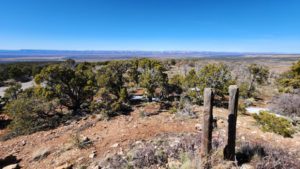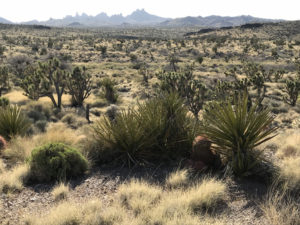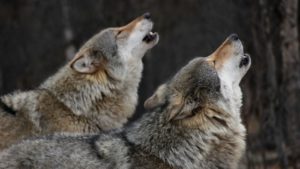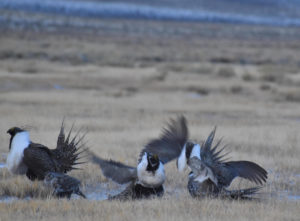Trying to Save Redband Trout While Agency Discretion Runs Amok
by Deb Hiller
Snake River Basin (SRB) redband trout are native to the high desert country of southern Idaho, northern Nevada, and eastern Oregon. This species is uniquely adapted to survive the harsh temperature extremes and reduced water flows of the high desert which are lethal to most other trout. SRB redband are an important element of the high desert ecosystem. They are the only native salmonid left in these drainages, and are a significant part of the food chain. Redband eat insects and other fish. They in turn are a food source for dippers, king fishers, mink, otters, and great blue herons.
SRB redband trout are also an evolutionary unique genetic resource which could be important to the survival of Snake River steelhead, as well as isolated resident redband populations now also imperiled. Historically SRB redband interbred with the recently listed anadromous Snake River steelhead and produced anadromous fors of SRB redband trout. However, the construction of the Hells Canyon dam complex in the 1960s blocked anadromous fish passage. Consequently Snake River steelhead continue to migrate to and from the ocean, while SRB redband trout reside their entire life inland in the Bruneau, Owhyee, Boise, and other Snake river tributaries. Whereas much of the native anadromous Snake River steelhead, gene pool has been lost to interbreeding with hatchery fish, the native gene pool of the SRB redband trout is still intact. Thus, where native gene pools of SRB redband trout have the ability to produce anadromous forms (were it not for the Hells Canyon Dam complex), SRB redband trout have the potential to provide the genetic diversity necessary for anadromous Snake River steelhead species survival.
Redband, like other species of trout, are found mainly in streams with riparian vegetation and in-stream cover, including undercut banks, large woody debris, and overhanging vegetation. Streamside vegetation should shade at least 75% of the stream surface during the hours of 11:00am to 4:00pm from June to September. Such vegetation provides both shade that maintains the lover water temperatures required by trout during hot, dry summer months, and habitat for insects which redband feed upon. Redband also occupy lower gradient streams and should have access to pools which provide rearing habitat, resting places, overwintering areas, and refuges from floods, drought, and extreme temperatures.
Although SRB redband trout are uniquely adaptable to reduced water flows and temperature extremes, their ability to survive temperatures increases and habitat destruction is currently being jeopardized by the interrelated effects of habitat degradation, dewatering, increased temperatures, poor water quality, isolation, and fragmentation. These effects are primarily caused by grazing and agricultural practices. In 1997, the USDA/USDI reported that resident interior redband trout, as a whole, are already extinct in 72% of their historic range of Idaho, Montana, Nevada, and Oregon. And in 1993, after finishing an inventory of SRB redband trout stocks in Owyhee County, Idaho (adjacent to the Oregon border), the Idaho Fish and Game Department found that SRB redband trout densities had decreased by an average of 87% in 80% of the stream segments along Jordan Creek since 1977.
Livestock grazing is the most widespread cause of degraded riparian habitat in the arid West. Livestock degrade redband trout habitat by trampling and removing streamside vegetation. The tramplind destroys undercut banks, flattens out pools, increases turbidity, and causes erosion associated with reduced vegetation cover and destabilization of stream banks. The results are shallow, wide streams. These are literally tenuously connected “mud puddles” that are too warm and turbid for juvenile rearing or adult spawning.
On an October 1997 camping trip to Noon Creek, Corral Creek, Cabin Creek, Juniper Creek, and Pole Creek in the North Fork and Middle Fork of the Owyhee drainage I encountered this phenomenon. I found redband trout (or fish for that matter) in only two of the five creeks. One of these creeks was trampled to the point that nothing but large puddles remained. The redband were literally stranded in stagnant water, dotted with numerous cow droppings. Evidence of recent cow use existed in every creek. The creek banks were either extremely cut on the edges to the point that large clumps of dirt crumbled into the small streams or so trampled that the banks were entirely gone replicating rodeo grounds. Except for areas excluded from cattle grazing, there was practically no streamside vegetation over two inches high.
Because the grazing and agriculture industries in Idaho refuse to change their land and water management practices to provide better habitat for redband trout, an endangered species listing for the trout is required. Unfortunately, the United States Fish & Wildlife Service (F&WS), through its inconsistent and nonscientific definition of species has refused to list SRB redband trout under the Endangered Species Act. For listing under the ESA, F&WS requires that a subspecies must qualify as a “distinct population segment” (meaning, among other things, that the species is separated from other populations of similar species, and exists in a unique ecological setting – characteristics apropos to SRB redband trout). However, in the last two decades, F&WS has frequently altered its “distinct population segment” definition in order to prevent several species from being listed. Such manipulation is what is occurring here.
In 1995, Idaho Watersheds Project along with seven other conservation groups petitioned F&WS to list SRB redband trout as an endangered species. Within two months, F&WS denied the petition on grounds that inland SRB redband trout are not a distinct population segment from steelhead or other trout, and that when all forms of the trout were combined, no ESA listing was warranted. Two years later, Snake River and other steelhead were listed as threatened and endangered. One would think that SRB redband trout, being in the same species category as steelhead, would have been included in the listing. However, F&WS again blocked the listing of SRB redband trout using reasoning directly contrary to that employed in the 1995 denial – this time proclaiming that SRB redband trout are distinct from steelhead and thus should not be included in the Snake River steelhead listing.
If this seems confusing, it is. But what should be evident is that F&WS inconsistently applied its species definition in order to prevent the SRB redband trout from being listed – a tactic used often by F&WS in order to avoid listings.
Timeline
- July 1995 – IWP final petition to list SRB redband filed
- September 1995 – F&WS denies petition on grounds SRB redband trout are not a distinct population segment from steelhead and other trout.
- August 1997 – Steelhead trout listed under the ESA – F&WS takes a diametrically contrary position asserting that redband trout are a distinct population from steelhead, and hence should not be listed along with steelhead.
This is not the only time the F&WS has manipulated policy on distinct population segments in order to avoid listing a species. In 1992, the agency refused to list the northern goshawk because it did not qualify as a distinct population segment. Upset with the F&WS’s policy on distinct population segments, the Southwest Center for Biological Diversity brought a suit in the U.S. District Court of Arizona. In 1996 the court ruled against F&WS finding their refusal to list northern goshawk arbitrary and capricious because there was no clear and consistent distinct population segment policy.” The court the remanded the listing decision back to the agency. Within three months, the F&WS again denied listing to the northern goshawk because it did not qualify as a distinct population segment. Southwest Center brought a second lawsuit. Once more the court ruled against F&WS for a second time finding the agency’s policy on distinct population segments “arbitrary and capricious and an abuse of [the F&WS’s] discretion.”
Early this summer the F&WS for the third time refused to list the northern goshawk. The decision has been denounced as a political effort by the F&WS to avoid conflicts with the timber industry. The aftermath may be a third northern goshawk lawsuit. Appropriately, the F&WS’s distinct population segment policy has been criticized for setting up a “recipe for endless technical bickering.” Of utmost concern is that while scientists and the courts debate over what constitutes a species, the creatures themselves edge ever closer to extinction.
The F&WS has also obscured and ignored data in order to avoid ESA listings. Courts have concluded that the F&WS acted arbitrarily and capriciously in refusing to list bull trout, the Alexander Archipelago wolf, the Queen Charlotte goshawk, and the Canada Lynx. In these cases the courts found that the F&WS either ignored the recommendations of its own biologists or failed to sue the best scientific data available in making listing determinations.
Lawsuits have been consistently necessary to obtain endangered species listing and to combat the politically swayed discretion of the F&WS. In response to F&WS’s latest political acquiescence – altering its distinct population segment policy in order to prevent the listing of SRB redband trout – Idaho Watersheds Project, Oregon Natural Desert Association, and Committee for Idaho’s High Desert, represented by the Land and Water Fund of the Rockies recently filed an Endangered Species Act lawsuit against the F&WS. Had the agency’s discretion not “run amok” and been applied consistently perhaps no such lawsuit would have been required. Unfortunately, however the F&WS has refused to act responsibly and apolitically to protect the seriously threatened SRB redband trout – placing the trout in dire circumstances.
Deb Hiller, originally from Idaho Falls, is an attorney in Boise.
Check out WWP’s archive of our semi-annual publication, the Watersheds Messenger






